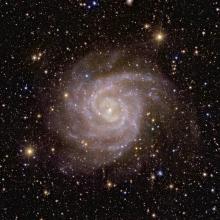Listen to today's episode of StarDate on the web the same day it airs in high-quality streaming audio without any extra ads or announcements. Choose a $8 one-month pass, or listen every day for a year for just $30.
You are here
Jupiter Opposition III
Dark matter is frustrating. Scientists know it’s there, but they can’t find it. And they’ve looked for evidence just about everywhere — including inside the planet Jupiter.
Dark matter produces no detectable energy of its own. But it pulls on the visible matter around it. From that, scientists have calculated that it’s several times more common than the ordinary matter we can see.
Dark matter may consist of subatomic particles. Early ideas said those particles should be especially heavy. But a couple of decades of searches haven’t found a thing. With each study, scientists push down the possible mass of dark-matter particles.
Such particles might ram together, producing gamma rays — the most powerful form of energy. So scientists are looking for the right kind of gamma rays from different kinds of astronomical objects. A recent study, for example, looked at Jupiter.
Astronomers monitored Jupiter’s gamma rays with a space telescope for more than a decade. Overall, there’s not much there. But there was a slight excess of gamma rays at wavelengths that could be produced by dark matter. The signal wasn’t nearly strong enough to confirm the presence of dark matter. But it may help scientists narrow down the explanation for these elusive particles.
And Jupiter is putting on its best showing of the year. It looks like a brilliant star low in the east shortly after sunset, and high in the south later on.
Script by Damond Benningfield





